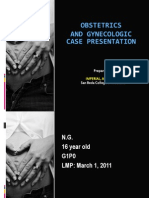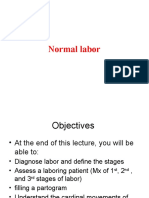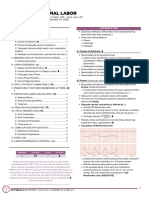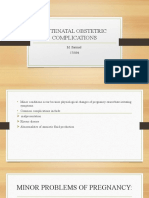Vaginal Birth After Caesarean (Vbac) : Max Brinsmead MB Bs PHD December 2015
Uploaded by
kikyVaginal Birth After Caesarean (Vbac) : Max Brinsmead MB Bs PHD December 2015
Uploaded by
kikyVaginal Birth after Caesarean
(VBAC)
Max Brinsmead MB BS PhD
December 2015
VBAC The Controversy
Once a Caesarean always a Caesarean
Edwin Cragin 1916
In an era of classical CS
Designed to prevent unnecessary primary CS
For 60 years Trial of (lower segment) scar
was standard British practice
But repeat CS more common in the US
Controversy broke out again in 2000
And it was all about fetal risks
VBAC The Controversy
Smith et al from Cambridge UK in JAMA 2002
Reviewed 313, 238 singleton births, 37 - 43w,
cephalic presentation in the Scottish Morbidity
Register 1992 -1997 excluding congenital
malformations and found
1. Rate of perinatal death 11 times higher for VBAC
compared to elective CS
2. This is 2 times higher than for multiparas having a
vaginal birth
VBAC The Controversy
Guise et al from Portland Oregan in BMJ July 2004
Reviewed 568 publications on VBAC vs elective
CS but found only 71 had useful data
Concluded that the additional risk of perinatal
death from attempted VBAC was 1.4 per 10,000
(95 percent confidence limits 0 - 9.8)
In only 5% of uterine ruptures did the baby die
This means that one has to perform 7142 elective
CS to prevent one baby death
This presentation will:
Examine the advantages and disadvantages
of VBAC
Evaluate the risks to mother & baby
Provide an evidence base for the safe
practice of VBAC...
Patient selection
Preparation of patients
Guidelines for intrapartum care
Advantages of VBAC
Greater maternal satisfaction
But its not all about me
Quicker recovery
But not always
Cheaper
But not much cheaper than elective CS and can be
much more costly
Less RDS for babies
But greater risk of death & disability
Less maternal morbidity and mortality
But these are rare with elective CS
Advantages of VBAC - 2
More vaginal births in the future
But whats the point if theres only to be two
kids!
Less maternal depression
But there is no evidence that this is so
Breast feeding more likely to succeed
Occurs in the delivery room
Easier for mothers without wound pain
Avoids risks unique to CS
But these are rare
Advantages of Elective CS
Certainty of timing
Thats the modern way!
Certainty of outcome
If I have a 30 50% chance of CS just do one!
Emergency CS more dangerous
Its Pain-free
More or less guaranteed!
Often preferred by fathers & obstetricians
Thats a male thing
Advantages of Elective CS
Protects the pelvic floor
Controversial because
Some risk arises from the pregnancy itself
And CS may not be protective
Safer for babies
But the absolute risk of VBAC is small
Avoids the risk of scar rupture
But there is much uncertainty about the
frequency of this
and the maternal and fetal risks
VBAC Risk to the Fetus
The rate of perinatal death is 11 x higher than
for elective CS
BUT
This risk is equivalent to that of being a fetus
to a Primigravida
The absolute risk is only 4.5 per 10,000 births
Confidence limits are wide
In the 2002 UK publication all emergency CS
were classified as attempted VBAC
Maternal Risk from VBAC
Meta analysis of risk of death
2.8 per 10,000 with trial of scar
2.4 per 10,000 for elective CS
No maternal death ever attributed to scar rupture
Scar rupture
Much confusion in the literature over the definition
Rate of asymptomatic scar rupture the same whether VBAC
or elect CS
Overall rate approx. 0.5% or 1:200
Was 0.35% in the largest combined contemporary study
Hysterectomy
Additional risk from trial of scar is 3.4 per 10,000
Requires 2941 elective CS to prevent one hysterectomy
Patient selection for VBAC
Type of previous CS
"10% " risk of rupture from classical and T incisions
Myomectomy and Hysterotomy
Indication for Previous CS
But 50-75% of patients can VBAC after previous CS for
CPD!
Previous obstetric history
VBAC success >90% if there has been prior vaginal birth
Dilatation at the time of previous CS
Gestation at previous CS was there a lower segment?
Number of previous CS
Increasing risk with increasing number
Patient selection for VBAC -2
Time since previous CS
Risk of scar rupture is 2 3x greater if <18m
Maternal weight
Miserable rates of VBAC for women >135 Kg
Lower uterine segment thickness
No uterine ruptures if >4.5 mm
Maternal Age
Clear evidence for declining uterine performance with age
at first labour
Family history of labour performance
A field ripe for study
Patient selection for VBAC - 3
Size of the mother and baby
But we are very bad at estimating this
Other pregnancy problems
Should be assessed according to obstetric principles
Engagement and cervical ripening
Best assessed at the onset of labour
Labour performance
Thats why its called trial of scar
Dilatation and descent
Progress rather than arbitrary time limits
Psychological Factors
The patients willingness and drive
The support provided
More than one previous CS?
Tahseen & Griffith BJOG Jan 2010 in a
systematic analysis of available data and
meta analysis concluded:
1.
2.
3.
4.
Overall success 71.1%
Risk of scar rupture 1.36% (this is 3x greater than
for one CS)
Perinatal risk is 0.09% (this is 3x greater than for
one CS)
The overall maternal morbidity was the same as
that for elective CS
Hysterectomy, transfusion, febrile morbidity etc
More than two previous CS?
Cahill et al BJOG 2010 in a retrospective
cohort study 89 women with >2 previous
CS concluded:
1.
2.
3.
Overall success 79.8%
No cases of uterine rupture
The overall maternal morbidity was the same as
that for elective CS
Hysterectomy, transfusion, febrile morbidity etc
Lower segment thickness and risk of scar rupture
Rozenberg et al Lancet 1996 studied 642 women with
ultrasound , measured the thinnest point of the lower
segment against a filled bladder, then attempted VBAC:
>4.5 mm - no ruptures or dehiscence
3.6 - 4.5 mm 2% rate of scar rupture
2.6 - 3.5 mm 10% rate of scar rupture
<2.6 mm
16% rate of scar rupture
(278)
(177)
(136)
(51)
Can be technically difficult particularly in obese woman
Vaginal and 3-dimensional measures promising
VBAC for the Obese?
Carrel et al (Am J OG in 2003) studied 70 women >200 lb, 70
who were 200-300 lb and 69 >300 lb
81.8% success for those <200 lb
57.1% success for those 200-300 lb
13.3% success for those >300 lb
Infection rate was:
5.7% group 1
11.4% group 2
39%
group 3
(Very similar results published in 2001)
VBAC for Older Women?
Byfield et al Am J OG in 2004 studied 659 women <30 years
age, 721 who were 30-35 years age and 370 >35 years age
72% success for those <30
71% success for those 30-35
65% success for those >35
Scar rupture rate was:
2.0% group 1
1.1% group 2
1.4% group 3
Pregnancy Interval and Risk of Scar Rupture
Byfield et al Am J OG in 2002 studied 1527 women who
attempted VBAC at <12 to >36 months after previous CS:
4.8% ruptured for those <12m
2.7% ruptured for those 13-24m
0.9% ruptured for those 25-36m
0.9% ruptured for those >36m
Pregnancy Interval and Risk of Scar Rupture
Bujold & Gauthier Obstet Gynec in 2010 studied 1768
women who attempted VBAC after one previous CS:
4.8% ruptured for those <18m
1.9% ruptured for those 18-24m
1.3% ruptured for those >24m
Also noted 7-fold increased rate of rupture
when the previous CS was a single layer
closure
Single vs Double-layer closure at prior CS
Blumenfeld et al BJOG in 2010 studied 127 women
undergoing primary CS.
At subsequent CS those who had a single
layer closure had a 7-fold increased risk of
bladder adhesions (RR=6.96, CI 1.72
28.1)
Regardless of any other variation in surgical
technique
Induction of Labour for VBAC?
Ravasia et al Am JOG 2000 studied 2119 women attempting
VBAC between 1992 and 1998 of whom 27% had an
induction of labour
Spontaneous labour
rate
Induced labour
Cx ripening c PGs
Cx ripening c Foley
IOL not using PGs
0.45% scar rupture
1.4%
2.9%
0.7%
0.7%
Induction of Labour for VBAC -2?
Lyndan-Rochelle et al NEJM 2001 studied all women
attempting VBAC between 1987 and 1996 in Washington
state
Rate of Scar Rupture
No labour
1.6 per 1000
Spontaneous labour
5.2 "
"
Induced labour (not PGs) 7.7 "
"
Induced with PGs
24.5 "
"
However this study used ICD9 codes for identifying scar
rupture and these are only 40% accurate
Induction of Labour for VBAC -3?
Lin & Rayner Am JOG 2004 studied 3533 women attempting
VBAC after one or more CS, 2523 in spontaneous labour,
438 by elective CS, 430 induced with oxytocin and 142
induced with Misoprostol
Rate of scar rupture was significantly higher
when labour was induced.
No significant difference between oxytocin
(0.8%) and Misoprostol (1.1%)
Induction of Labour for VBAC -4?
Dekkar et al studied 29,008 women attempting VBAC in
Australia 1998 2000 BJOG 117:1358 2010
Rate of scar rupture (complete & partial ) was:
No labour
Spontaneous labour with no augmentation
Labour augmented with oxytocin
Induced using oxytocin
Induced using prostaglandins (PGs)
Induced with PGs and oxytocin
Overall rate of successful VBAC
0.01%
0.15%
1.91%
0.54%
0.68%
0.88%
54.3%
RCOG Guidelines 2015 - 1
Use a checklist when counselling patients in
preparation
Give them an information sheet
Contraindications
Previous uterine rupture
Any contraindication to labour in this pregnancy eg
placenta previa, transverse lie etc.
Exercise caution for
More than one previous section
Complicated previous uterine scar
Post term, Twins, Macromia, Maternal age >40
RCOG Guidelines 2015 - 2
Induction of labour
Increases the risk of rupture 2-3fold especially if
prostaglandins are used
Reduces the chance of VBAC 1.5-fold
Requires an appropriately staffed and
equipped maternity unit
Intrapartum
Use continuous CTG
Epidural okay but think about scar rupture if there is
escalation of pain
My guidelines for VBAC - 1
Patients are counselled that VBAC is not
usually recommended if:
There is a classical, T-shaped or unknown
uterine incision
More than one CS has been performed
The previous CS was performed for failure to
progress in the active phase of labour i.e. >4 cm
dilated
Their BMI is >35
Patients accepted outside of these guidelines on a caseby-case basis.
My guidelines for VBAC - 2
Patients who are suitable for a trial of scar
should be told by their primary carer that
elective CS and VBAC have risks and
benefits.
They should:
Read on the subject RCOG 2008
Discuss it with an obstetrician
Their decision will be respected
Patients planning VBAC require one to one
preparation
My guidelines for VBAC - 3
Any available record about the previous CS
is scrutinized
The patient is provided with individualised
chance of success with VBAC & maternal
and fetal risks
Delivery in a place capable of emergency
laparotomy is recommended
Any limitation in the patients chosen place
of birth is discussed
The discussion is documented
My guidelines for VBAC - 4
Offer IOL by sweep membranes, ARM and
oxytocin in safe working hours at 39 41w
Cervical ripening with Foley but not PGs
If admitted in spontaneous labour then
review by obstetrician within 2 hrs is
desirable
IV line, group and save
Epidural if required.
Monitor by continuous CTG if oxytocin or
epidural is in use
My guidelines for VBAC - 5
CS is recommended if there is failure to
progress i.e.
<1 cm per hour dilatation over >4 hrs and >3 cm
and good uterine activity
No head descent with >60 minutes active pushing in
the 2nd stage
Assisted delivery may be attempted according to
usual obstetric dictates
OR Fetal Distress i.e.
Scalp lactate >4.8 or CTG so abnormal as to warrant
scalp sampling by RCOG guidelines
My experience with VBAC - 1
330 private multigravid patients 2001 04
65 had undergone previous CS (20%)
32 attempted VBAC (50%)
21were successful (66%)
12 by SVD and 9 assisted
My experience with VBAC - 2
Among the 32 VBACs there were:
2 patients who had 2 previous CS (one with a thin lower
segment)
5 patients whose previous CS was for failure to progress
and 2 of these had a bigger baby during VBAC
1 patient who had a third degree tear in her first SVD,
elective CS for the second and SVD with an intact
perineum during VBAC
Any Questions or Comments?
Please leave a note on the Welcome
Page to the website
You might also like
- Physiotherapy in Obstetrics and Gynaecology 2nd Edition100% (1)Physiotherapy in Obstetrics and Gynaecology 2nd Edition493 pages
- Vaginal Birth After Previous Caesarean Section100% (1)Vaginal Birth After Previous Caesarean Section26 pages
- Vaginal Birth After Caesarean Section (Vbac)50% (2)Vaginal Birth After Caesarean Section (Vbac)16 pages
- Operative Delivery: Presenters: Yonas Gudeta (RMHS/402/09)100% (1)Operative Delivery: Presenters: Yonas Gudeta (RMHS/402/09)71 pages
- Hypertensive Disorders of Pregnancy: Mohammad Khalandar (116) Megha D100% (1)Hypertensive Disorders of Pregnancy: Mohammad Khalandar (116) Megha D22 pages
- Preterm Prelabor Rupture of Membranes - Clinical Manifestations and Diagnosis - UpToDateNo ratings yetPreterm Prelabor Rupture of Membranes - Clinical Manifestations and Diagnosis - UpToDate21 pages
- Case Report: Tikur Anbesa Specialized HospitalNo ratings yetCase Report: Tikur Anbesa Specialized Hospital11 pages
- Ivfluidtherapytypesindicationsdosescalculation 130123090523 Phpapp01No ratings yetIvfluidtherapytypesindicationsdosescalculation 130123090523 Phpapp0168 pages
- Queenan's Management of High-Risk Pregnancy: An Evidence-Based ApproachFrom EverandQueenan's Management of High-Risk Pregnancy: An Evidence-Based ApproachNo ratings yet
- OBG BOOKLET BY WIN NURSING COACHNING_240301_210221No ratings yetOBG BOOKLET BY WIN NURSING COACHNING_240301_210221198 pages
- Vaginal Discharge-Causes, Diagnosis, and Treatment: ABC of Sexually Transmitted InfectionsNo ratings yetVaginal Discharge-Causes, Diagnosis, and Treatment: ABC of Sexually Transmitted Infections3 pages
- Maternal and Child Nursing Care 3rd Edition London Test BankNo ratings yetMaternal and Child Nursing Care 3rd Edition London Test Bank11 pages
- Iii. Section A: Multiple Choice QuestionsNo ratings yetIii. Section A: Multiple Choice Questions22 pages
- Clinical Presentations and Surgical Management of Uterine Septum-Associated Infertility: A Case Series StudyNo ratings yetClinical Presentations and Surgical Management of Uterine Septum-Associated Infertility: A Case Series Study6 pages
- Equine Internal Medicine, 4th Edition - Reed-1227-1351No ratings yetEquine Internal Medicine, 4th Edition - Reed-1227-1351125 pages
- Common Diseases of The Reproductive SystemNo ratings yetCommon Diseases of The Reproductive System5 pages
- Clinical Case Proforma For M.S. Research Work: Affiliated by Utkal University, Vanivihar, Bhubaneswar, OdishaNo ratings yetClinical Case Proforma For M.S. Research Work: Affiliated by Utkal University, Vanivihar, Bhubaneswar, Odisha8 pages
- Department of Obstetrics & Gynecology-Wwrc Emergency Duty July 2020No ratings yetDepartment of Obstetrics & Gynecology-Wwrc Emergency Duty July 20203 pages
- Reproductive Pharmacology Lecturio ReflectionNo ratings yetReproductive Pharmacology Lecturio Reflection7 pages
- Physiotherapy in Obstetrics and Gynaecology 2nd EditionPhysiotherapy in Obstetrics and Gynaecology 2nd Edition
- Operative Delivery: Presenters: Yonas Gudeta (RMHS/402/09)Operative Delivery: Presenters: Yonas Gudeta (RMHS/402/09)
- Hypertensive Disorders of Pregnancy: Mohammad Khalandar (116) Megha DHypertensive Disorders of Pregnancy: Mohammad Khalandar (116) Megha D
- Preterm Prelabor Rupture of Membranes - Clinical Manifestations and Diagnosis - UpToDatePreterm Prelabor Rupture of Membranes - Clinical Manifestations and Diagnosis - UpToDate
- Ivfluidtherapytypesindicationsdosescalculation 130123090523 Phpapp01Ivfluidtherapytypesindicationsdosescalculation 130123090523 Phpapp01
- Queenan's Management of High-Risk Pregnancy: An Evidence-Based ApproachFrom EverandQueenan's Management of High-Risk Pregnancy: An Evidence-Based Approach
- OBG BOOKLET BY WIN NURSING COACHNING_240301_210221OBG BOOKLET BY WIN NURSING COACHNING_240301_210221
- Vaginal Discharge-Causes, Diagnosis, and Treatment: ABC of Sexually Transmitted InfectionsVaginal Discharge-Causes, Diagnosis, and Treatment: ABC of Sexually Transmitted Infections
- Maternal and Child Nursing Care 3rd Edition London Test BankMaternal and Child Nursing Care 3rd Edition London Test Bank
- Clinical Presentations and Surgical Management of Uterine Septum-Associated Infertility: A Case Series StudyClinical Presentations and Surgical Management of Uterine Septum-Associated Infertility: A Case Series Study
- Equine Internal Medicine, 4th Edition - Reed-1227-1351Equine Internal Medicine, 4th Edition - Reed-1227-1351
- Clinical Case Proforma For M.S. Research Work: Affiliated by Utkal University, Vanivihar, Bhubaneswar, OdishaClinical Case Proforma For M.S. Research Work: Affiliated by Utkal University, Vanivihar, Bhubaneswar, Odisha
- Department of Obstetrics & Gynecology-Wwrc Emergency Duty July 2020Department of Obstetrics & Gynecology-Wwrc Emergency Duty July 2020

























































































